Apple Inc.: Supply Chain Challenges and Strategies Report
VerifiedAdded on 2021/04/17
|12
|3020
|106
Report
AI Summary
This report provides a comprehensive analysis of Apple Inc.'s supply chain management. It begins with an executive summary and introduction, setting the stage for a critical analysis of the challenges Apple faces, including new product development complexities, supplier relationships, and maintaining brand image amidst production cost pressures. The report then delves into Apple's sourcing strategies, outlining both the benefits, such as risk diversification and increased production capacity, and limitations, including quality control concerns. Furthermore, it examines the performance objectives of Apple's suppliers, emphasizing cost minimization, relationship maintenance, technological advancements, and quality provision. The report concludes by summarizing the key findings and emphasizing the importance of effective supply chain management for Apple's continued success.
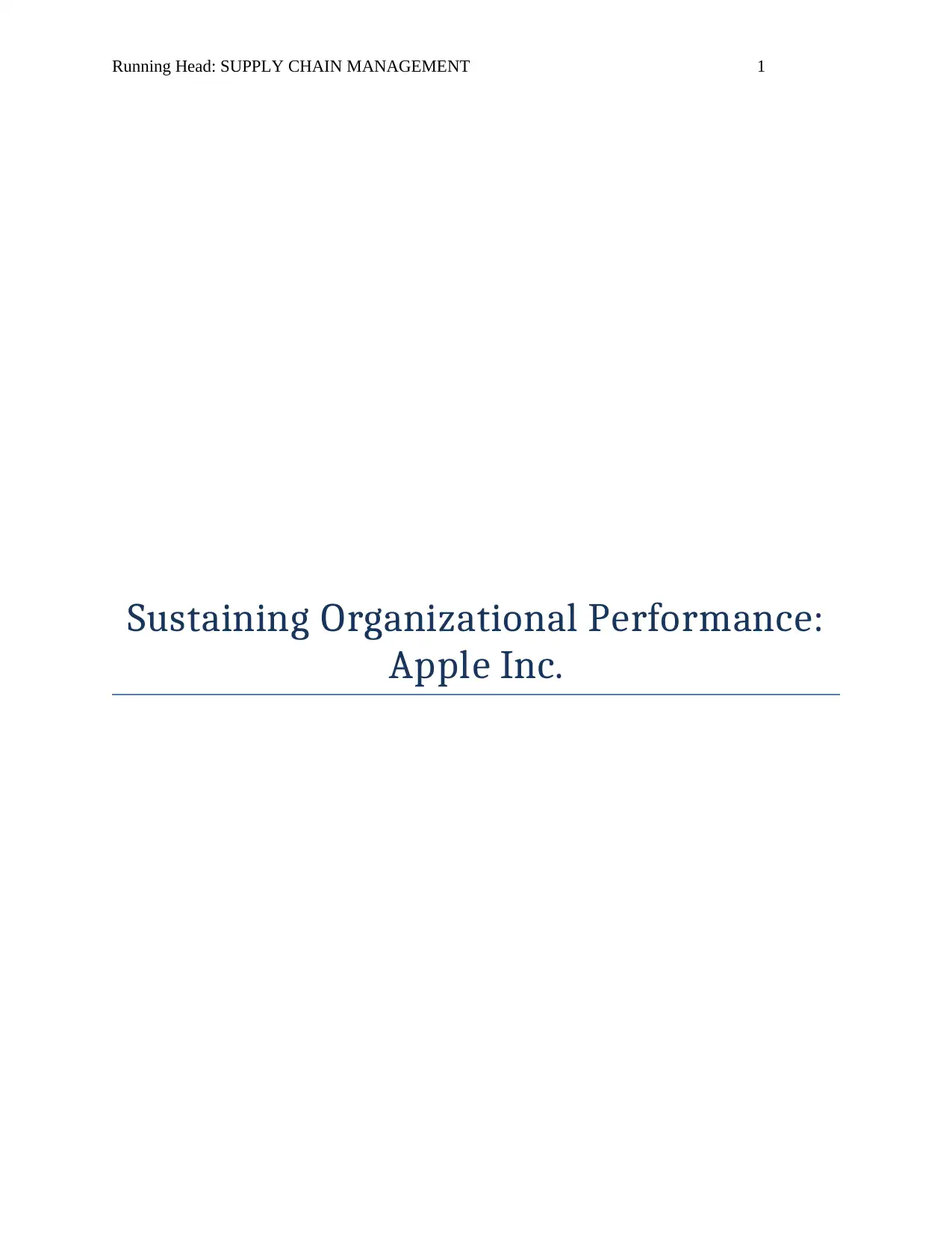
Running Head: SUPPLY CHAIN MANAGEMENT 1
Sustaining Organizational Performance:
Apple Inc.
Sustaining Organizational Performance:
Apple Inc.
Paraphrase This Document
Need a fresh take? Get an instant paraphrase of this document with our AI Paraphraser
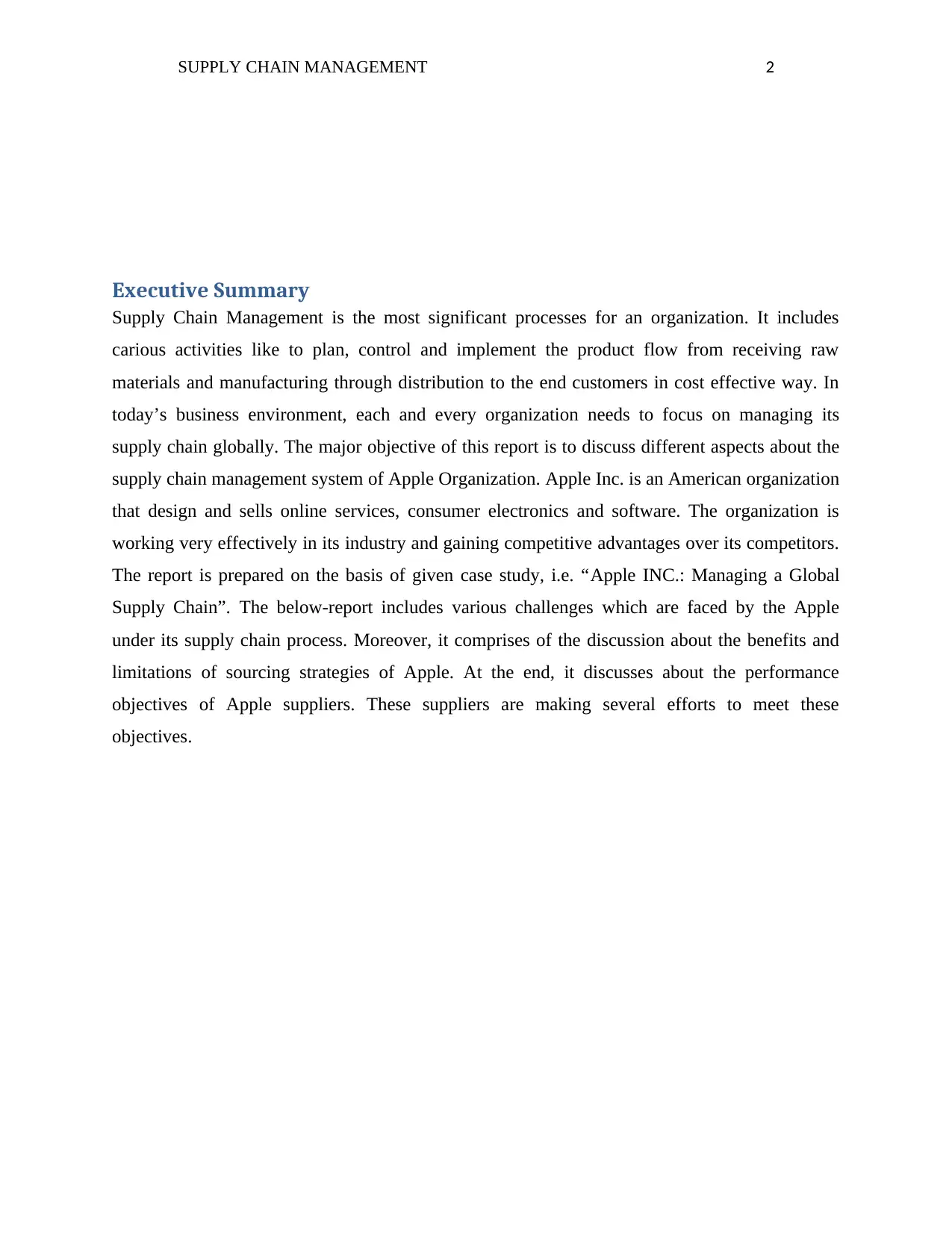
SUPPLY CHAIN MANAGEMENT 2
Executive Summary
Supply Chain Management is the most significant processes for an organization. It includes
carious activities like to plan, control and implement the product flow from receiving raw
materials and manufacturing through distribution to the end customers in cost effective way. In
today’s business environment, each and every organization needs to focus on managing its
supply chain globally. The major objective of this report is to discuss different aspects about the
supply chain management system of Apple Organization. Apple Inc. is an American organization
that design and sells online services, consumer electronics and software. The organization is
working very effectively in its industry and gaining competitive advantages over its competitors.
The report is prepared on the basis of given case study, i.e. “Apple INC.: Managing a Global
Supply Chain”. The below-report includes various challenges which are faced by the Apple
under its supply chain process. Moreover, it comprises of the discussion about the benefits and
limitations of sourcing strategies of Apple. At the end, it discusses about the performance
objectives of Apple suppliers. These suppliers are making several efforts to meet these
objectives.
Executive Summary
Supply Chain Management is the most significant processes for an organization. It includes
carious activities like to plan, control and implement the product flow from receiving raw
materials and manufacturing through distribution to the end customers in cost effective way. In
today’s business environment, each and every organization needs to focus on managing its
supply chain globally. The major objective of this report is to discuss different aspects about the
supply chain management system of Apple Organization. Apple Inc. is an American organization
that design and sells online services, consumer electronics and software. The organization is
working very effectively in its industry and gaining competitive advantages over its competitors.
The report is prepared on the basis of given case study, i.e. “Apple INC.: Managing a Global
Supply Chain”. The below-report includes various challenges which are faced by the Apple
under its supply chain process. Moreover, it comprises of the discussion about the benefits and
limitations of sourcing strategies of Apple. At the end, it discusses about the performance
objectives of Apple suppliers. These suppliers are making several efforts to meet these
objectives.
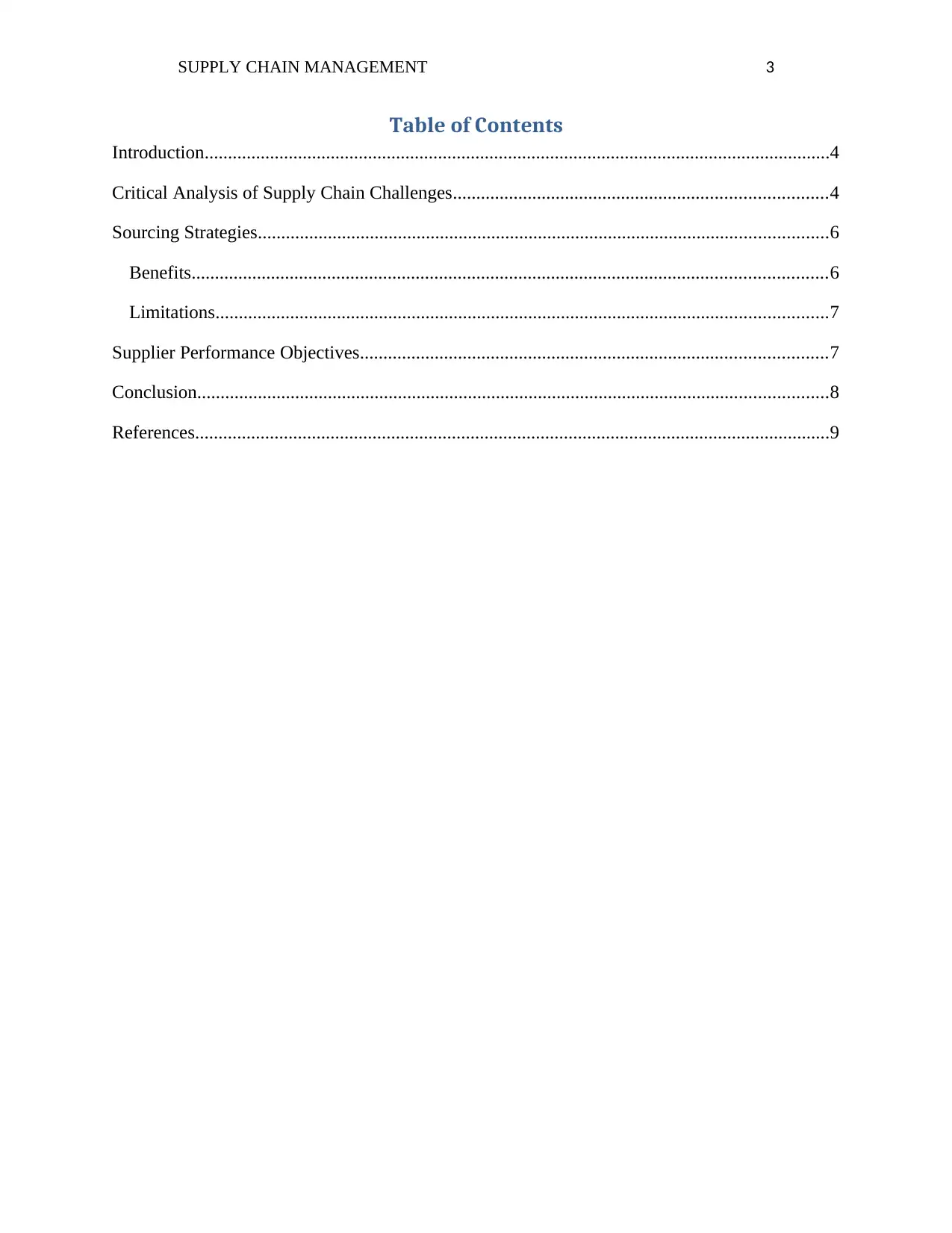
SUPPLY CHAIN MANAGEMENT 3
Table of Contents
Introduction......................................................................................................................................4
Critical Analysis of Supply Chain Challenges................................................................................4
Sourcing Strategies..........................................................................................................................6
Benefits........................................................................................................................................6
Limitations...................................................................................................................................7
Supplier Performance Objectives....................................................................................................7
Conclusion.......................................................................................................................................8
References........................................................................................................................................9
Table of Contents
Introduction......................................................................................................................................4
Critical Analysis of Supply Chain Challenges................................................................................4
Sourcing Strategies..........................................................................................................................6
Benefits........................................................................................................................................6
Limitations...................................................................................................................................7
Supplier Performance Objectives....................................................................................................7
Conclusion.......................................................................................................................................8
References........................................................................................................................................9
⊘ This is a preview!⊘
Do you want full access?
Subscribe today to unlock all pages.

Trusted by 1+ million students worldwide
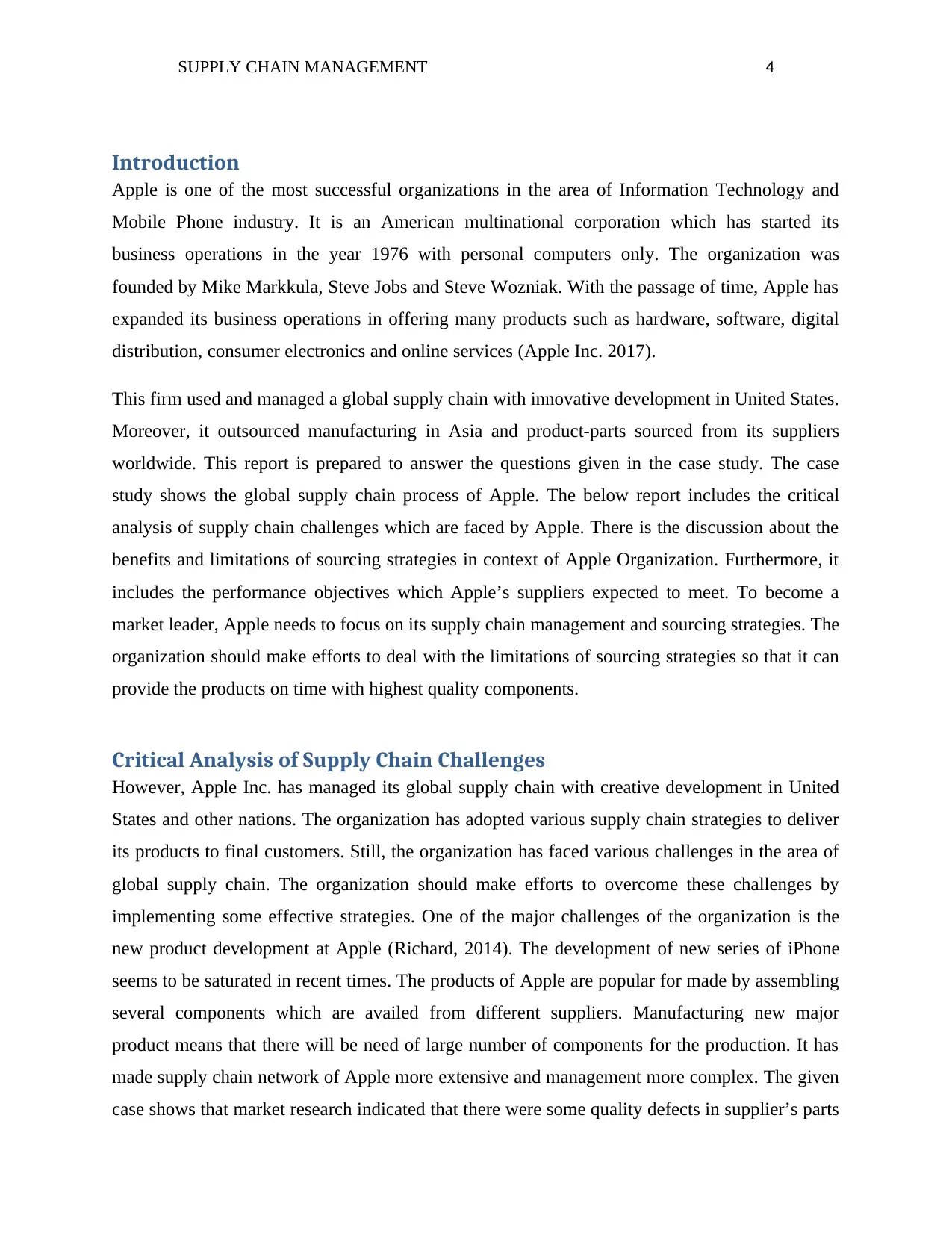
SUPPLY CHAIN MANAGEMENT 4
Introduction
Apple is one of the most successful organizations in the area of Information Technology and
Mobile Phone industry. It is an American multinational corporation which has started its
business operations in the year 1976 with personal computers only. The organization was
founded by Mike Markkula, Steve Jobs and Steve Wozniak. With the passage of time, Apple has
expanded its business operations in offering many products such as hardware, software, digital
distribution, consumer electronics and online services (Apple Inc. 2017).
This firm used and managed a global supply chain with innovative development in United States.
Moreover, it outsourced manufacturing in Asia and product-parts sourced from its suppliers
worldwide. This report is prepared to answer the questions given in the case study. The case
study shows the global supply chain process of Apple. The below report includes the critical
analysis of supply chain challenges which are faced by Apple. There is the discussion about the
benefits and limitations of sourcing strategies in context of Apple Organization. Furthermore, it
includes the performance objectives which Apple’s suppliers expected to meet. To become a
market leader, Apple needs to focus on its supply chain management and sourcing strategies. The
organization should make efforts to deal with the limitations of sourcing strategies so that it can
provide the products on time with highest quality components.
Critical Analysis of Supply Chain Challenges
However, Apple Inc. has managed its global supply chain with creative development in United
States and other nations. The organization has adopted various supply chain strategies to deliver
its products to final customers. Still, the organization has faced various challenges in the area of
global supply chain. The organization should make efforts to overcome these challenges by
implementing some effective strategies. One of the major challenges of the organization is the
new product development at Apple (Richard, 2014). The development of new series of iPhone
seems to be saturated in recent times. The products of Apple are popular for made by assembling
several components which are availed from different suppliers. Manufacturing new major
product means that there will be need of large number of components for the production. It has
made supply chain network of Apple more extensive and management more complex. The given
case shows that market research indicated that there were some quality defects in supplier’s parts
Introduction
Apple is one of the most successful organizations in the area of Information Technology and
Mobile Phone industry. It is an American multinational corporation which has started its
business operations in the year 1976 with personal computers only. The organization was
founded by Mike Markkula, Steve Jobs and Steve Wozniak. With the passage of time, Apple has
expanded its business operations in offering many products such as hardware, software, digital
distribution, consumer electronics and online services (Apple Inc. 2017).
This firm used and managed a global supply chain with innovative development in United States.
Moreover, it outsourced manufacturing in Asia and product-parts sourced from its suppliers
worldwide. This report is prepared to answer the questions given in the case study. The case
study shows the global supply chain process of Apple. The below report includes the critical
analysis of supply chain challenges which are faced by Apple. There is the discussion about the
benefits and limitations of sourcing strategies in context of Apple Organization. Furthermore, it
includes the performance objectives which Apple’s suppliers expected to meet. To become a
market leader, Apple needs to focus on its supply chain management and sourcing strategies. The
organization should make efforts to deal with the limitations of sourcing strategies so that it can
provide the products on time with highest quality components.
Critical Analysis of Supply Chain Challenges
However, Apple Inc. has managed its global supply chain with creative development in United
States and other nations. The organization has adopted various supply chain strategies to deliver
its products to final customers. Still, the organization has faced various challenges in the area of
global supply chain. The organization should make efforts to overcome these challenges by
implementing some effective strategies. One of the major challenges of the organization is the
new product development at Apple (Richard, 2014). The development of new series of iPhone
seems to be saturated in recent times. The products of Apple are popular for made by assembling
several components which are availed from different suppliers. Manufacturing new major
product means that there will be need of large number of components for the production. It has
made supply chain network of Apple more extensive and management more complex. The given
case shows that market research indicated that there were some quality defects in supplier’s parts
Paraphrase This Document
Need a fresh take? Get an instant paraphrase of this document with our AI Paraphraser

SUPPLY CHAIN MANAGEMENT 5
of iPhones. This is because Apple has less focus on its research and development division
(Marucheck, et al, 2011). Apple has made efforts to add new technology and design in its new
version and products. The followers of company are expecting more technology breakthrough in
new products. It has affected the sales growth of iPhone and declining rate of products is high.
The organization is unable to ensure its production capacity and order volume with the suppliers.
In addition to this, the organization has faced the challenges in managing sustainable
relationships with new or existing suppliers (Wallace, & Hill, 2011). It secures the supply of
components to meet the market demand by buying a large volume of parts from its suppliers with
the prepayment. It is very difficult for the suppliers to get the orders from other customers. Thus,
suppliers have become dependent on the order of Apple to generate more profits (Slack, 2015).
With this prepayment, Apple’s suppliers have higher pressure to provide the components with
Just-in-Time production process. They have realized a slim profit from this company so suppliers
changed their attitudes. Due to this, some of the suppliers have declined the orders of Apple to
manage their independence. Just-in-Time supply chain of Apple placed a burden on the
suppliers’ shoulders (Jacobs, Chase, & Lummus, 2014). Delay in the components’ supply had an
adverse impact on the inventory projections of Apple.
Moreover, Apple has faced the challenge in maintaining its brand image. The organization has
been alleged of cooperating with the factories in its upstream supply chain. Because of its Just-
in-Time production, immediate order or changes in requirements, the phone assembler may need
their employees to work overtime for fulfilling the needs of Apple (Chamberlain, 2011). The
supply chain of Apple is managed in such a way that it led the organization to higher cost of
production. The organization is continuously making efforts to minimize the production costs,
but it still has higher production cost in comparison to its competing brands such as Samsung,
Nokia etc. Apart from above challenges, other challenges are such as organization is very much
dependent on logistical services which are offered by outsourced suppliers. There may be
possibility that these suppliers can offer the lower quality of materials and products. It relies on
its partners to comply with the code of conduct of suppliers (Kozlenkova, et al, 2015). Thus, the
organization has to make some improvements in its supply chain so that it can minimize the
costs. It needs to review its transportation model and procurement strategy to lower the
of iPhones. This is because Apple has less focus on its research and development division
(Marucheck, et al, 2011). Apple has made efforts to add new technology and design in its new
version and products. The followers of company are expecting more technology breakthrough in
new products. It has affected the sales growth of iPhone and declining rate of products is high.
The organization is unable to ensure its production capacity and order volume with the suppliers.
In addition to this, the organization has faced the challenges in managing sustainable
relationships with new or existing suppliers (Wallace, & Hill, 2011). It secures the supply of
components to meet the market demand by buying a large volume of parts from its suppliers with
the prepayment. It is very difficult for the suppliers to get the orders from other customers. Thus,
suppliers have become dependent on the order of Apple to generate more profits (Slack, 2015).
With this prepayment, Apple’s suppliers have higher pressure to provide the components with
Just-in-Time production process. They have realized a slim profit from this company so suppliers
changed their attitudes. Due to this, some of the suppliers have declined the orders of Apple to
manage their independence. Just-in-Time supply chain of Apple placed a burden on the
suppliers’ shoulders (Jacobs, Chase, & Lummus, 2014). Delay in the components’ supply had an
adverse impact on the inventory projections of Apple.
Moreover, Apple has faced the challenge in maintaining its brand image. The organization has
been alleged of cooperating with the factories in its upstream supply chain. Because of its Just-
in-Time production, immediate order or changes in requirements, the phone assembler may need
their employees to work overtime for fulfilling the needs of Apple (Chamberlain, 2011). The
supply chain of Apple is managed in such a way that it led the organization to higher cost of
production. The organization is continuously making efforts to minimize the production costs,
but it still has higher production cost in comparison to its competing brands such as Samsung,
Nokia etc. Apart from above challenges, other challenges are such as organization is very much
dependent on logistical services which are offered by outsourced suppliers. There may be
possibility that these suppliers can offer the lower quality of materials and products. It relies on
its partners to comply with the code of conduct of suppliers (Kozlenkova, et al, 2015). Thus, the
organization has to make some improvements in its supply chain so that it can minimize the
costs. It needs to review its transportation model and procurement strategy to lower the
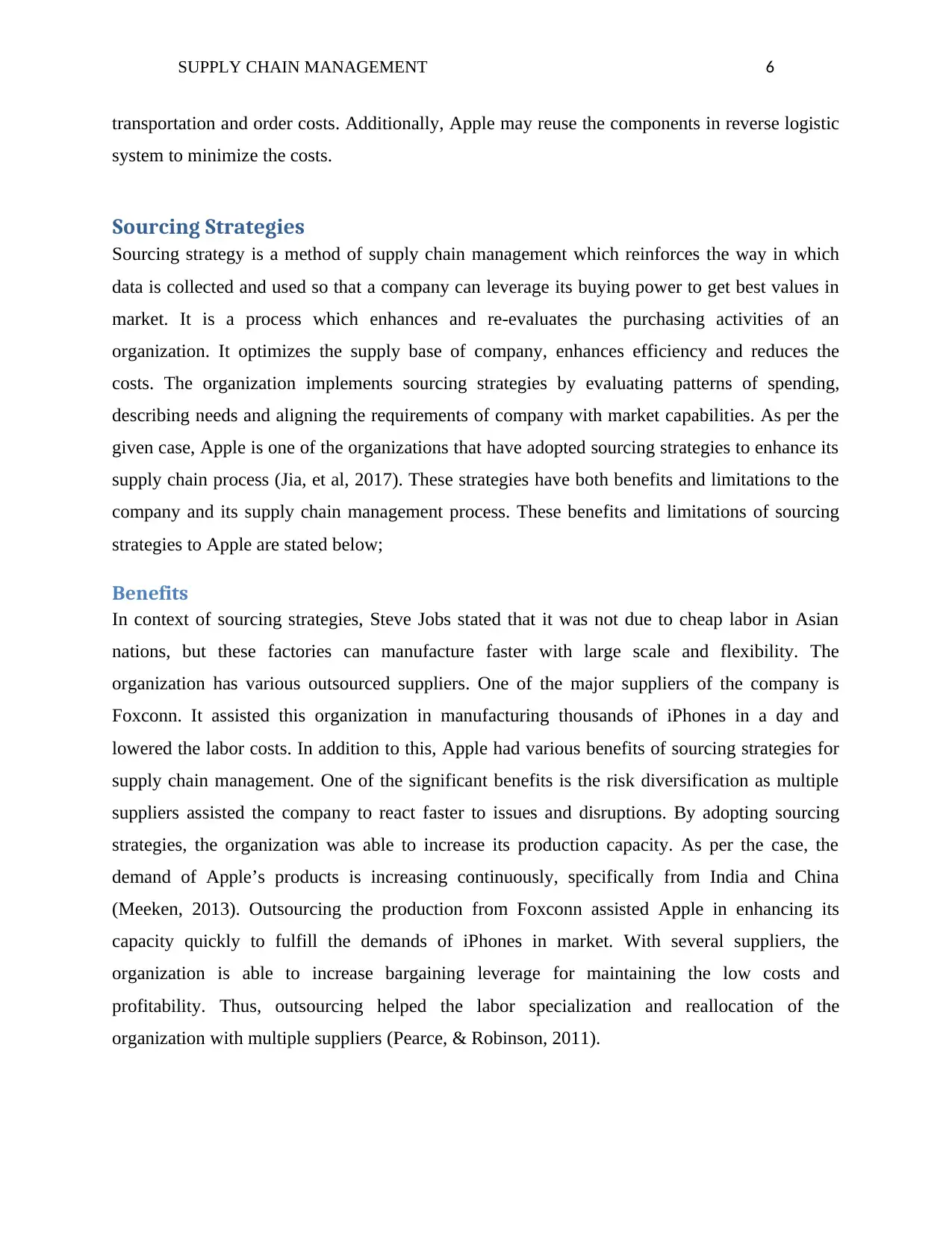
SUPPLY CHAIN MANAGEMENT 6
transportation and order costs. Additionally, Apple may reuse the components in reverse logistic
system to minimize the costs.
Sourcing Strategies
Sourcing strategy is a method of supply chain management which reinforces the way in which
data is collected and used so that a company can leverage its buying power to get best values in
market. It is a process which enhances and re-evaluates the purchasing activities of an
organization. It optimizes the supply base of company, enhances efficiency and reduces the
costs. The organization implements sourcing strategies by evaluating patterns of spending,
describing needs and aligning the requirements of company with market capabilities. As per the
given case, Apple is one of the organizations that have adopted sourcing strategies to enhance its
supply chain process (Jia, et al, 2017). These strategies have both benefits and limitations to the
company and its supply chain management process. These benefits and limitations of sourcing
strategies to Apple are stated below;
Benefits
In context of sourcing strategies, Steve Jobs stated that it was not due to cheap labor in Asian
nations, but these factories can manufacture faster with large scale and flexibility. The
organization has various outsourced suppliers. One of the major suppliers of the company is
Foxconn. It assisted this organization in manufacturing thousands of iPhones in a day and
lowered the labor costs. In addition to this, Apple had various benefits of sourcing strategies for
supply chain management. One of the significant benefits is the risk diversification as multiple
suppliers assisted the company to react faster to issues and disruptions. By adopting sourcing
strategies, the organization was able to increase its production capacity. As per the case, the
demand of Apple’s products is increasing continuously, specifically from India and China
(Meeken, 2013). Outsourcing the production from Foxconn assisted Apple in enhancing its
capacity quickly to fulfill the demands of iPhones in market. With several suppliers, the
organization is able to increase bargaining leverage for maintaining the low costs and
profitability. Thus, outsourcing helped the labor specialization and reallocation of the
organization with multiple suppliers (Pearce, & Robinson, 2011).
transportation and order costs. Additionally, Apple may reuse the components in reverse logistic
system to minimize the costs.
Sourcing Strategies
Sourcing strategy is a method of supply chain management which reinforces the way in which
data is collected and used so that a company can leverage its buying power to get best values in
market. It is a process which enhances and re-evaluates the purchasing activities of an
organization. It optimizes the supply base of company, enhances efficiency and reduces the
costs. The organization implements sourcing strategies by evaluating patterns of spending,
describing needs and aligning the requirements of company with market capabilities. As per the
given case, Apple is one of the organizations that have adopted sourcing strategies to enhance its
supply chain process (Jia, et al, 2017). These strategies have both benefits and limitations to the
company and its supply chain management process. These benefits and limitations of sourcing
strategies to Apple are stated below;
Benefits
In context of sourcing strategies, Steve Jobs stated that it was not due to cheap labor in Asian
nations, but these factories can manufacture faster with large scale and flexibility. The
organization has various outsourced suppliers. One of the major suppliers of the company is
Foxconn. It assisted this organization in manufacturing thousands of iPhones in a day and
lowered the labor costs. In addition to this, Apple had various benefits of sourcing strategies for
supply chain management. One of the significant benefits is the risk diversification as multiple
suppliers assisted the company to react faster to issues and disruptions. By adopting sourcing
strategies, the organization was able to increase its production capacity. As per the case, the
demand of Apple’s products is increasing continuously, specifically from India and China
(Meeken, 2013). Outsourcing the production from Foxconn assisted Apple in enhancing its
capacity quickly to fulfill the demands of iPhones in market. With several suppliers, the
organization is able to increase bargaining leverage for maintaining the low costs and
profitability. Thus, outsourcing helped the labor specialization and reallocation of the
organization with multiple suppliers (Pearce, & Robinson, 2011).
⊘ This is a preview!⊘
Do you want full access?
Subscribe today to unlock all pages.

Trusted by 1+ million students worldwide
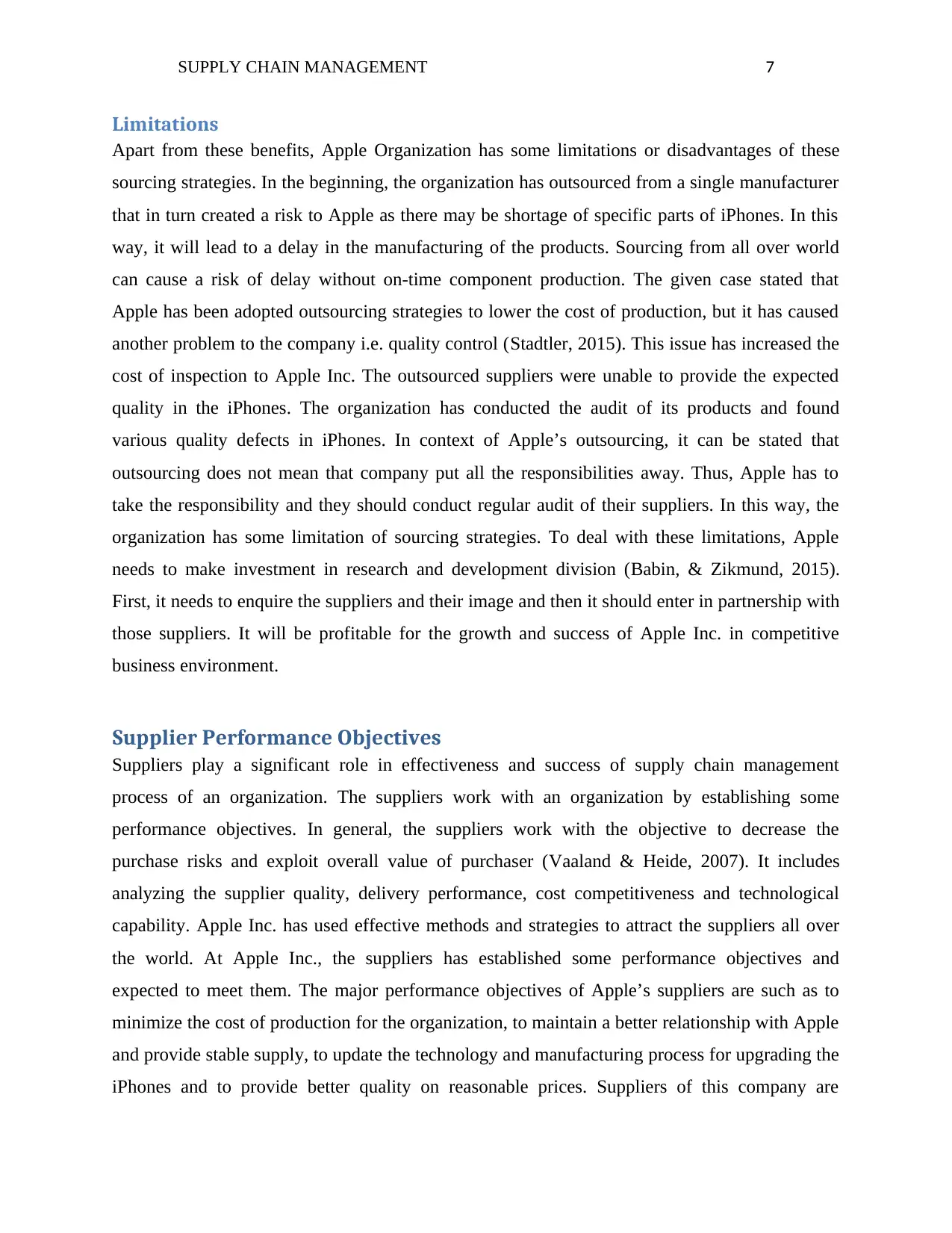
SUPPLY CHAIN MANAGEMENT 7
Limitations
Apart from these benefits, Apple Organization has some limitations or disadvantages of these
sourcing strategies. In the beginning, the organization has outsourced from a single manufacturer
that in turn created a risk to Apple as there may be shortage of specific parts of iPhones. In this
way, it will lead to a delay in the manufacturing of the products. Sourcing from all over world
can cause a risk of delay without on-time component production. The given case stated that
Apple has been adopted outsourcing strategies to lower the cost of production, but it has caused
another problem to the company i.e. quality control (Stadtler, 2015). This issue has increased the
cost of inspection to Apple Inc. The outsourced suppliers were unable to provide the expected
quality in the iPhones. The organization has conducted the audit of its products and found
various quality defects in iPhones. In context of Apple’s outsourcing, it can be stated that
outsourcing does not mean that company put all the responsibilities away. Thus, Apple has to
take the responsibility and they should conduct regular audit of their suppliers. In this way, the
organization has some limitation of sourcing strategies. To deal with these limitations, Apple
needs to make investment in research and development division (Babin, & Zikmund, 2015).
First, it needs to enquire the suppliers and their image and then it should enter in partnership with
those suppliers. It will be profitable for the growth and success of Apple Inc. in competitive
business environment.
Supplier Performance Objectives
Suppliers play a significant role in effectiveness and success of supply chain management
process of an organization. The suppliers work with an organization by establishing some
performance objectives. In general, the suppliers work with the objective to decrease the
purchase risks and exploit overall value of purchaser (Vaaland & Heide, 2007). It includes
analyzing the supplier quality, delivery performance, cost competitiveness and technological
capability. Apple Inc. has used effective methods and strategies to attract the suppliers all over
the world. At Apple Inc., the suppliers has established some performance objectives and
expected to meet them. The major performance objectives of Apple’s suppliers are such as to
minimize the cost of production for the organization, to maintain a better relationship with Apple
and provide stable supply, to update the technology and manufacturing process for upgrading the
iPhones and to provide better quality on reasonable prices. Suppliers of this company are
Limitations
Apart from these benefits, Apple Organization has some limitations or disadvantages of these
sourcing strategies. In the beginning, the organization has outsourced from a single manufacturer
that in turn created a risk to Apple as there may be shortage of specific parts of iPhones. In this
way, it will lead to a delay in the manufacturing of the products. Sourcing from all over world
can cause a risk of delay without on-time component production. The given case stated that
Apple has been adopted outsourcing strategies to lower the cost of production, but it has caused
another problem to the company i.e. quality control (Stadtler, 2015). This issue has increased the
cost of inspection to Apple Inc. The outsourced suppliers were unable to provide the expected
quality in the iPhones. The organization has conducted the audit of its products and found
various quality defects in iPhones. In context of Apple’s outsourcing, it can be stated that
outsourcing does not mean that company put all the responsibilities away. Thus, Apple has to
take the responsibility and they should conduct regular audit of their suppliers. In this way, the
organization has some limitation of sourcing strategies. To deal with these limitations, Apple
needs to make investment in research and development division (Babin, & Zikmund, 2015).
First, it needs to enquire the suppliers and their image and then it should enter in partnership with
those suppliers. It will be profitable for the growth and success of Apple Inc. in competitive
business environment.
Supplier Performance Objectives
Suppliers play a significant role in effectiveness and success of supply chain management
process of an organization. The suppliers work with an organization by establishing some
performance objectives. In general, the suppliers work with the objective to decrease the
purchase risks and exploit overall value of purchaser (Vaaland & Heide, 2007). It includes
analyzing the supplier quality, delivery performance, cost competitiveness and technological
capability. Apple Inc. has used effective methods and strategies to attract the suppliers all over
the world. At Apple Inc., the suppliers has established some performance objectives and
expected to meet them. The major performance objectives of Apple’s suppliers are such as to
minimize the cost of production for the organization, to maintain a better relationship with Apple
and provide stable supply, to update the technology and manufacturing process for upgrading the
iPhones and to provide better quality on reasonable prices. Suppliers of this company are
Paraphrase This Document
Need a fresh take? Get an instant paraphrase of this document with our AI Paraphraser

SUPPLY CHAIN MANAGEMENT 8
accountable for quality of their services and supplies (Apple Inc., 2018). To maintain and
enhance the higher quality for customers, the suppliers need to focus on effective quality
management system. They should be loyal to the company and its production system.
In addition to this, the suppliers of Apple are expecting to generate significant profits by
supplying the components and other materials to Apple’s manufacturers. They are aimed to
enhance the performance of Apple that assists its suppliers in achieving identification among
manufacturers. They are competing on different factors other than price of materials only. As
mentioned above, Apple is adopting Just-in-Time system for the production of iPhones so
suppliers ensure that they have complete resource and material availability when organization
needs. The suppliers at Apple are performing with the objective to increase the business and
market share of Apple. They are striving to enhance the operational efficiencies to differentiate
Apple from itself from competing brands. In addition to this, they are performing their
responsibilities with the objective to offer the materials and components of reasonable prices that
is favorable for both Apple and its suppliers itself (Mangan, Lalwani, & Lalwani, 2016). These
performance objectives of suppliers are stated in the code of conduct of Apple Inc. The suppliers
are making efforts to meet these performance objectives. Meeting these objectives successfully
will be very effective and beneficial for the growth and success of Apple’s business.
Conclusion
From the above analysis, it can be concluded that Apple Inc. has maintained its top position in
Information Technology and mobile phone industry. With the support of suppliers, the
organization offers several products like iPad, iPhone, iPod, Apple TV, Smart watch etc. In
addition to this, it provides online services like iOS app store, iTunes Store, iCloud, Mac App
Store etc. Apple is successfully managing its global supply chain system and manufacturing
products by using Just-in-Time process. The above report concludes that this company has faced
some challenges under its supply chain process. However, it has faced various challenges but
supply chain of Apple is not that much complex.
To deal with these challenges, it has adopted sourcing strategies. These strategies are both
advantageous and disadvantageous for company’s growth and brand image. Apple has to
emphasize on its research and development process and make investment in marketing research.
accountable for quality of their services and supplies (Apple Inc., 2018). To maintain and
enhance the higher quality for customers, the suppliers need to focus on effective quality
management system. They should be loyal to the company and its production system.
In addition to this, the suppliers of Apple are expecting to generate significant profits by
supplying the components and other materials to Apple’s manufacturers. They are aimed to
enhance the performance of Apple that assists its suppliers in achieving identification among
manufacturers. They are competing on different factors other than price of materials only. As
mentioned above, Apple is adopting Just-in-Time system for the production of iPhones so
suppliers ensure that they have complete resource and material availability when organization
needs. The suppliers at Apple are performing with the objective to increase the business and
market share of Apple. They are striving to enhance the operational efficiencies to differentiate
Apple from itself from competing brands. In addition to this, they are performing their
responsibilities with the objective to offer the materials and components of reasonable prices that
is favorable for both Apple and its suppliers itself (Mangan, Lalwani, & Lalwani, 2016). These
performance objectives of suppliers are stated in the code of conduct of Apple Inc. The suppliers
are making efforts to meet these performance objectives. Meeting these objectives successfully
will be very effective and beneficial for the growth and success of Apple’s business.
Conclusion
From the above analysis, it can be concluded that Apple Inc. has maintained its top position in
Information Technology and mobile phone industry. With the support of suppliers, the
organization offers several products like iPad, iPhone, iPod, Apple TV, Smart watch etc. In
addition to this, it provides online services like iOS app store, iTunes Store, iCloud, Mac App
Store etc. Apple is successfully managing its global supply chain system and manufacturing
products by using Just-in-Time process. The above report concludes that this company has faced
some challenges under its supply chain process. However, it has faced various challenges but
supply chain of Apple is not that much complex.
To deal with these challenges, it has adopted sourcing strategies. These strategies are both
advantageous and disadvantageous for company’s growth and brand image. Apple has to
emphasize on its research and development process and make investment in marketing research.
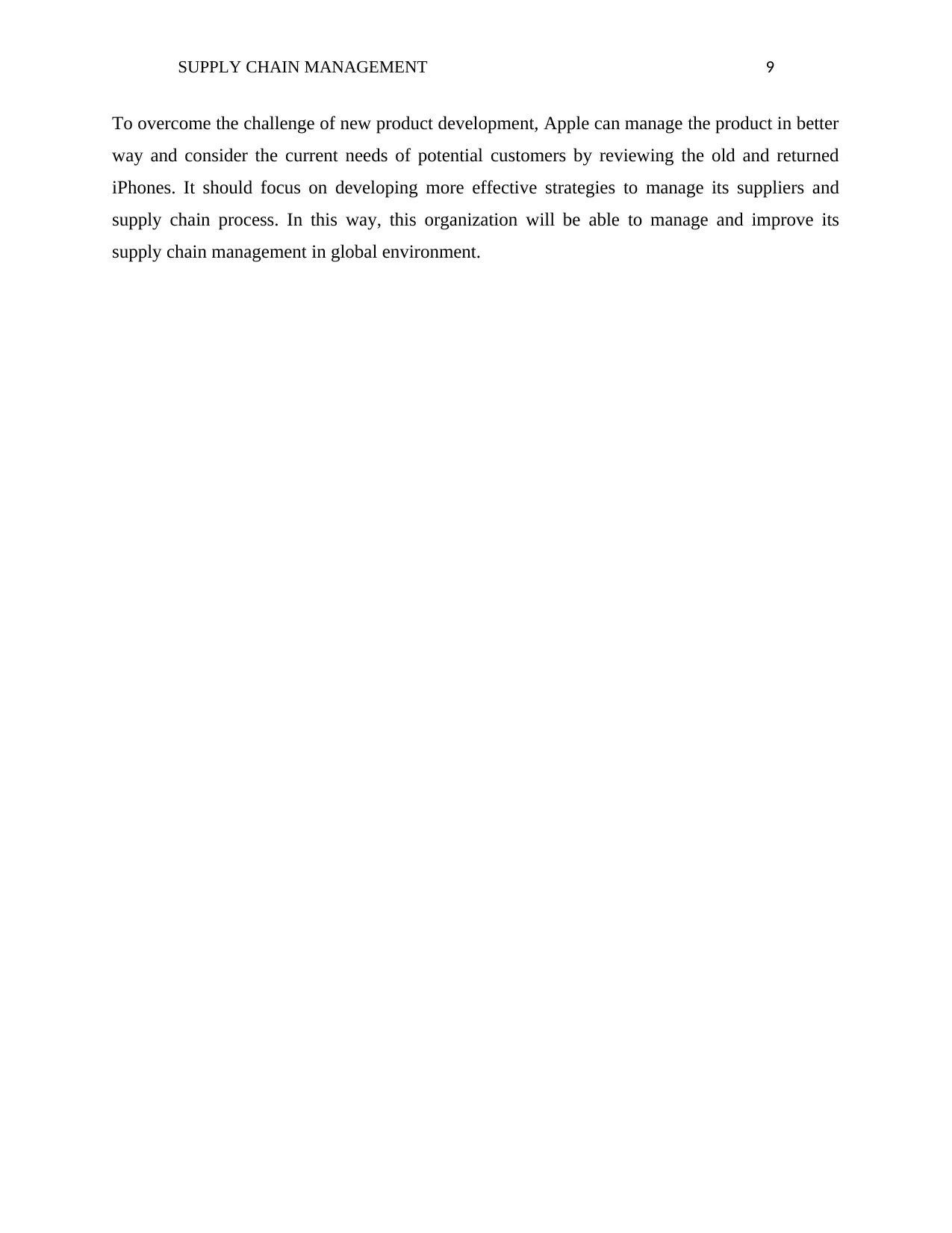
SUPPLY CHAIN MANAGEMENT 9
To overcome the challenge of new product development, Apple can manage the product in better
way and consider the current needs of potential customers by reviewing the old and returned
iPhones. It should focus on developing more effective strategies to manage its suppliers and
supply chain process. In this way, this organization will be able to manage and improve its
supply chain management in global environment.
To overcome the challenge of new product development, Apple can manage the product in better
way and consider the current needs of potential customers by reviewing the old and returned
iPhones. It should focus on developing more effective strategies to manage its suppliers and
supply chain process. In this way, this organization will be able to manage and improve its
supply chain management in global environment.
⊘ This is a preview!⊘
Do you want full access?
Subscribe today to unlock all pages.

Trusted by 1+ million students worldwide
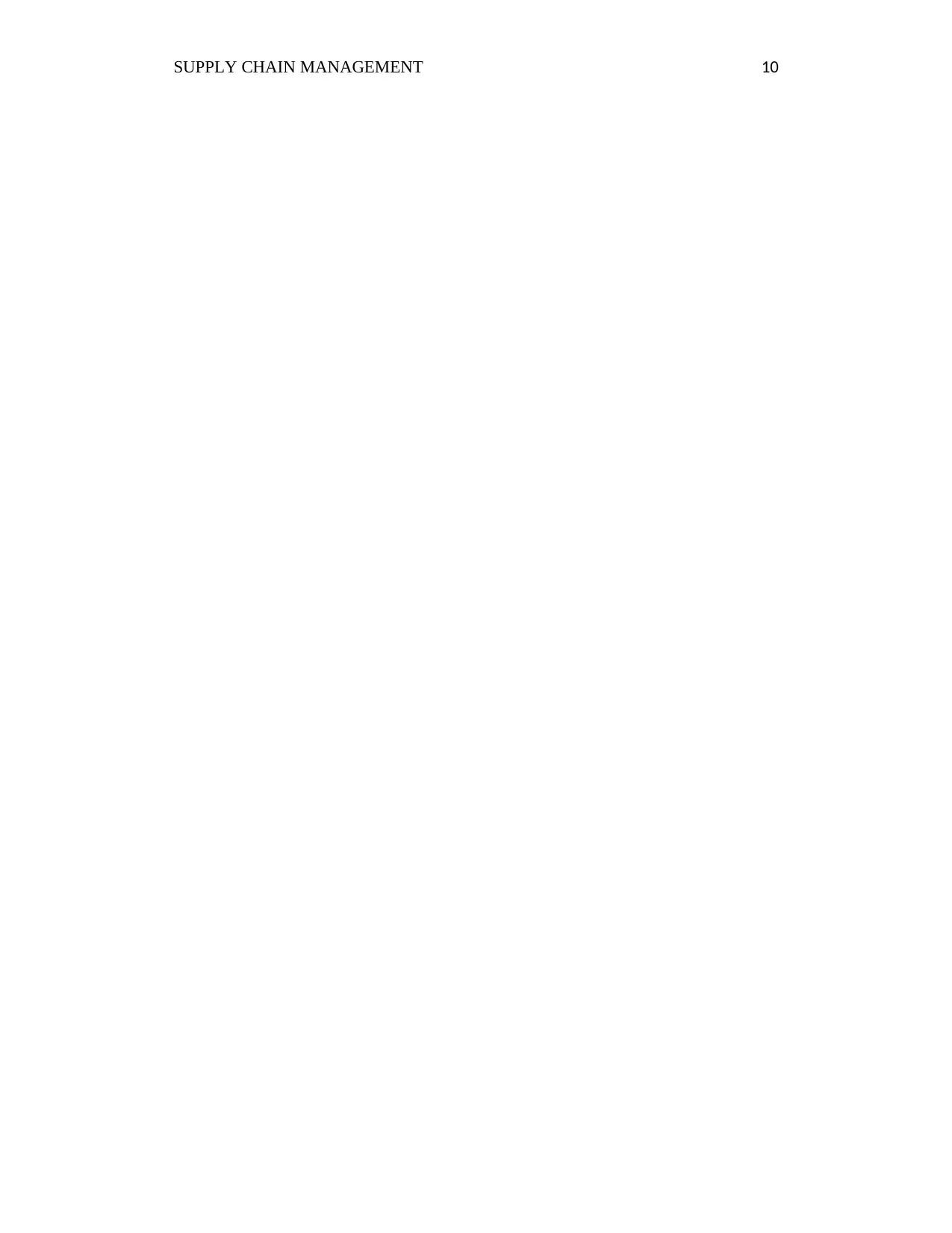
SUPPLY CHAIN MANAGEMENT 10
Paraphrase This Document
Need a fresh take? Get an instant paraphrase of this document with our AI Paraphraser

SUPPLY CHAIN MANAGEMENT 11
References
Apple Inc. (2017). About Apple Inc. Retrieved from https://www.apple.com/in/ on 26 March
2018.
Apple Inc. (2018). Supplier Responsibility. Retrieved from https://www.apple.com/in/supplier-
responsibility/ on 26 March 2018.
Babin, B. J., & Zikmund, W. G. (2015). Exploring marketing research. UK. Cengage Learning.
Chamberlain, G. (2011). Apple's Chinese workers treated 'inhumanely, like machines. Retrieved
from https://www.theguardian.com/technology/2011/apr/30/apple-chinese-workers-
treated-inhumanely on 26 March 2018.
Jacobs, F. R., Chase, R. B., & Lummus, R. R. (2014). Operations and supply chain
management (pp. 533-535). New York, NY: McGraw-Hill/Irwin.
Jia, F., Orzes, G., Sartor, M., & Nassimbeni, G. (2017). Global sourcing strategy and structure:
towards a conceptual framework. International Journal of Operations & Production
Management, 37(7), 840-864.
Kozlenkova, I. V., Hult, G. T. M., Lund, D. J., Mena, J. A., & Kekec, P. (2015). The role of
marketing channels in supply chain management. Journal of Retailing, 91(4), 586-609.
Mangan, J., Lalwani, C., & Lalwani, C. L. (2016). Global logistics and supply chain
management. US. John Wiley & Sons.
Marucheck, A., Greis, N., Mena, C., & Cai, L. (2011). Product safety and security in the global
supply chain: Issues, challenges and research opportunities. Journal of Operations
Management, 29(7-8), 707-720.
Meeken, Z. (2013). The Risks and Benefits of Outsourcing Supply Chain Management.
Retrieved from https://www.business.org/software/supplier/the-risks-and-benefits-of-
outsourcing-supply-chain-management/ on 26 March 2018.
Pearce, JA., & Robinson, RB. (2011). Strategic management: Formulation, implementation, and
control. 12th edn. UK. McGraw Hill Higher Education.
References
Apple Inc. (2017). About Apple Inc. Retrieved from https://www.apple.com/in/ on 26 March
2018.
Apple Inc. (2018). Supplier Responsibility. Retrieved from https://www.apple.com/in/supplier-
responsibility/ on 26 March 2018.
Babin, B. J., & Zikmund, W. G. (2015). Exploring marketing research. UK. Cengage Learning.
Chamberlain, G. (2011). Apple's Chinese workers treated 'inhumanely, like machines. Retrieved
from https://www.theguardian.com/technology/2011/apr/30/apple-chinese-workers-
treated-inhumanely on 26 March 2018.
Jacobs, F. R., Chase, R. B., & Lummus, R. R. (2014). Operations and supply chain
management (pp. 533-535). New York, NY: McGraw-Hill/Irwin.
Jia, F., Orzes, G., Sartor, M., & Nassimbeni, G. (2017). Global sourcing strategy and structure:
towards a conceptual framework. International Journal of Operations & Production
Management, 37(7), 840-864.
Kozlenkova, I. V., Hult, G. T. M., Lund, D. J., Mena, J. A., & Kekec, P. (2015). The role of
marketing channels in supply chain management. Journal of Retailing, 91(4), 586-609.
Mangan, J., Lalwani, C., & Lalwani, C. L. (2016). Global logistics and supply chain
management. US. John Wiley & Sons.
Marucheck, A., Greis, N., Mena, C., & Cai, L. (2011). Product safety and security in the global
supply chain: Issues, challenges and research opportunities. Journal of Operations
Management, 29(7-8), 707-720.
Meeken, Z. (2013). The Risks and Benefits of Outsourcing Supply Chain Management.
Retrieved from https://www.business.org/software/supplier/the-risks-and-benefits-of-
outsourcing-supply-chain-management/ on 26 March 2018.
Pearce, JA., & Robinson, RB. (2011). Strategic management: Formulation, implementation, and
control. 12th edn. UK. McGraw Hill Higher Education.
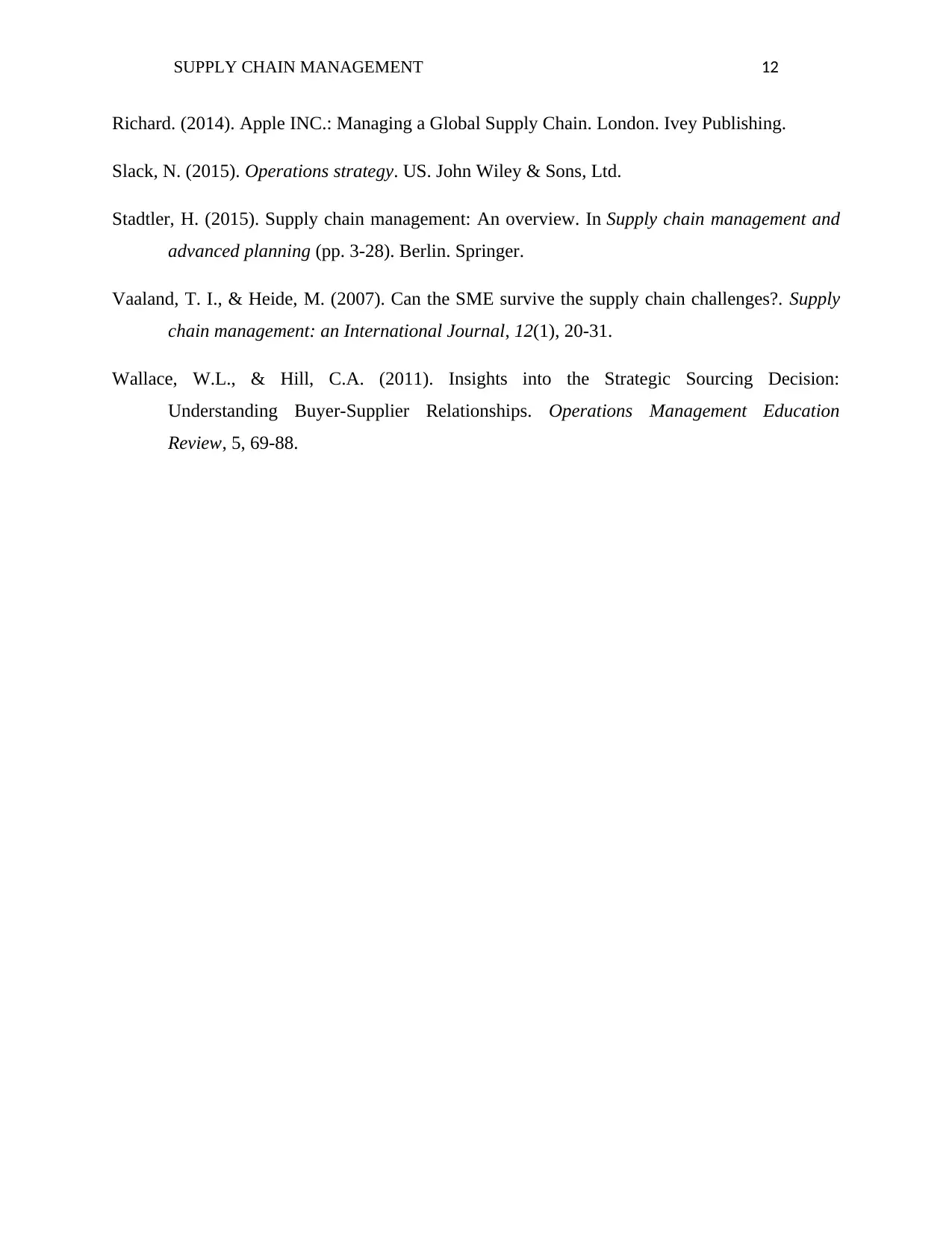
SUPPLY CHAIN MANAGEMENT 12
Richard. (2014). Apple INC.: Managing a Global Supply Chain. London. Ivey Publishing.
Slack, N. (2015). Operations strategy. US. John Wiley & Sons, Ltd.
Stadtler, H. (2015). Supply chain management: An overview. In Supply chain management and
advanced planning (pp. 3-28). Berlin. Springer.
Vaaland, T. I., & Heide, M. (2007). Can the SME survive the supply chain challenges?. Supply
chain management: an International Journal, 12(1), 20-31.
Wallace, W.L., & Hill, C.A. (2011). Insights into the Strategic Sourcing Decision:
Understanding Buyer-Supplier Relationships. Operations Management Education
Review, 5, 69-88.
Richard. (2014). Apple INC.: Managing a Global Supply Chain. London. Ivey Publishing.
Slack, N. (2015). Operations strategy. US. John Wiley & Sons, Ltd.
Stadtler, H. (2015). Supply chain management: An overview. In Supply chain management and
advanced planning (pp. 3-28). Berlin. Springer.
Vaaland, T. I., & Heide, M. (2007). Can the SME survive the supply chain challenges?. Supply
chain management: an International Journal, 12(1), 20-31.
Wallace, W.L., & Hill, C.A. (2011). Insights into the Strategic Sourcing Decision:
Understanding Buyer-Supplier Relationships. Operations Management Education
Review, 5, 69-88.
⊘ This is a preview!⊘
Do you want full access?
Subscribe today to unlock all pages.

Trusted by 1+ million students worldwide
1 out of 12
Related Documents
Your All-in-One AI-Powered Toolkit for Academic Success.
+13062052269
info@desklib.com
Available 24*7 on WhatsApp / Email
![[object Object]](/_next/static/media/star-bottom.7253800d.svg)
Unlock your academic potential
Copyright © 2020–2025 A2Z Services. All Rights Reserved. Developed and managed by ZUCOL.





